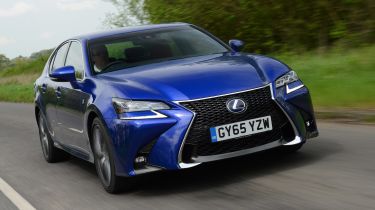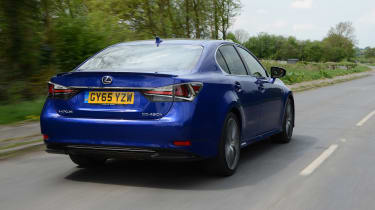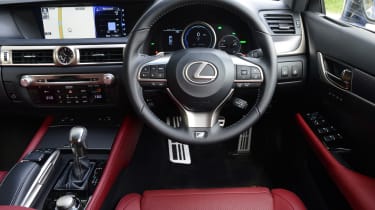Lexus GS 450h F Sport 2016 review
Can the sporty Lexus GS 450h F Sport hybrid take the fight to its executive rivals?

The GS 450h F Sport is a handsome left-field alternative to the mainstream exec contenders, but no more than that. It fails to deliver the sporty, involving drive to support its badge, and forgoes one of the GS hybrid’s key strengths - fuel efficiency and low BIK bills - in the process. So it’s hard to recommend this high-end model; if you’re considering a GS, we’d suggest you stick with the more modest GS 300h and make the savings on your company car bill.
Lexus is continuing to push ahead with a mix of petrol models and hybrids in its line-up, eschewing the diesels that tend to dominate the ranges of rivals like BMW, Audi and Mercedes. Indeed, the push to part-electrification extends to more than one hybrid in the company’s mid-sized model, the GS, with the potent GS450h sitting above the GS300h.
• Best executive cars on sale right now
We’ve now had a chance to try the revised GS, in range-topping 450h F Sport trim and on UK roads. The GS 450h mixes a 3.5-litre V6 petrol engine with an electric motor for a hefty combined output of 341bhp and 352Nm of torque - enough for a 0-62mph dash in under six seconds and top speed of 155mph. The power is transmitted to the rear wheels via Lexus’s Shiftmatic - which is, in reality, a CVT transmission that incorporates six sequential steps to make it feel like a conventional automatic.
F Sport takes the already-appealing GS shape and focuses it further, with a different design of front grille, a revised front bumper on the outside and aluminium trim flashes in the cabin.
Used - available now

2021 Audi
A6
28,288 milesAutomaticPetrol2.0L
Cash £27,400
2022 Vauxhall
Corsa
10,873 milesAutomaticPetrol1.2L
Cash £14,700
2025 BMW
i4
19,952 milesAutomaticElectric
Cash £31,000
2024 SEAT
Ibiza
28,777 milesAutomaticPetrol1.0L
Cash £14,500The sportier trim also brings larger 19in wheels than the regular GS 450h, but there is a small hit in CO2 emissions as a result. They nudge up from 141g/km to 145g/km, enough to raise the BIK from 25 percent to 26 percent. Combined fuel economy drops by less than a single mile per gallon, meanwhile - although in truth, you’re unlikely to get north of 40mpg, let alone match the official 45.6mpg of the GS 450h F Sport.
• Best hybrid cars on the market
On the road, the GS 450h is swift without ever coming close to feeling fast. Indeed, it’s fair to say that this car does a remarkably good job of hiding its performance potential under a bushel; the hybrid drive system does give you that satisfying instant jump of acceleration, but then - as has so often been the case - the Shiftmatic system takes over and you’re left feeling pretty detached from the whole experience.
Lexus claims, of course, that it has never had a single complaint about its drivetrain, and that owners simply acclimatise to the different driving style required. That may hold true on more modest hybrids, but on something with the F Sport badge it’s disappointing to find that any more than a relaxed driving style brings audible groans from the engine as the gearbox sends the revs skywards, and they stay there.
At least things calm down on the cruise, where the powertrain has more than enough reserves to hold a sensible motorway speed without feeling strained. The F Sport’s larger wheels don’t ruin the GS’s ride, either; it’s unmistakably firm, but ultimately strikes a pretty good balance between body control and comfort.
There are useful additions to the GS’s list of safety kit as part of this year’s facelift. You now get a pre-crash system with pedestrian detection, adaptive cruise control, lane keep assist and traffic sign recognition. F Sport and Premier models also add adaptive high beam headlights, blind spot monitoring and an alert system that watches the rear of the car for passing traffic and pedestrians as you reverse.
Inside, there’s no doubting the quality of the materials, which is first rate, with tight build quality, prodigious use of double-stitched leather and flashes of brushed metal finish. F Sport brings a digital rev counter that can adjust its display as you move through the car’s modes and shift your focus from efficiency to performance.
Lexus’s infotainment system is based around a central 12.3-inch display, mounted high up in the centre of the fascia. It’s a clear enough screen, but the interface - operated by a mouse-like controller that incorporates haptic feedback to give you resistance as you move from area to area - is a bit fiddly. The systems in BMWs, Mercedes, Audis and Jaguars are all less complex to use on the move.
Indeed, the GS’s biggest problem is that beyond the infotainment set-up, its opposition also offers a more conventional and rewarding drive, with numbers that still manage to impress. Assuming you’re not hung up on having a limited amount pure-electric running, BMW’s 535d is similarly priced, quicker and more involving on the road, and actually marginally more efficient on CO2 emissions than the GS 450h F Sport.
Mercedes’ all-new E-Class is more compelling still, with comparable performance in E350d trim, CO2 emissions of just 136g/km and a lower list price that’d help further with your BIK bill. Many of these rivals are more practical, too, with split rear seats available to boost the boot space, even as an option; the GS’s capacity is fixed at 482 litres.











